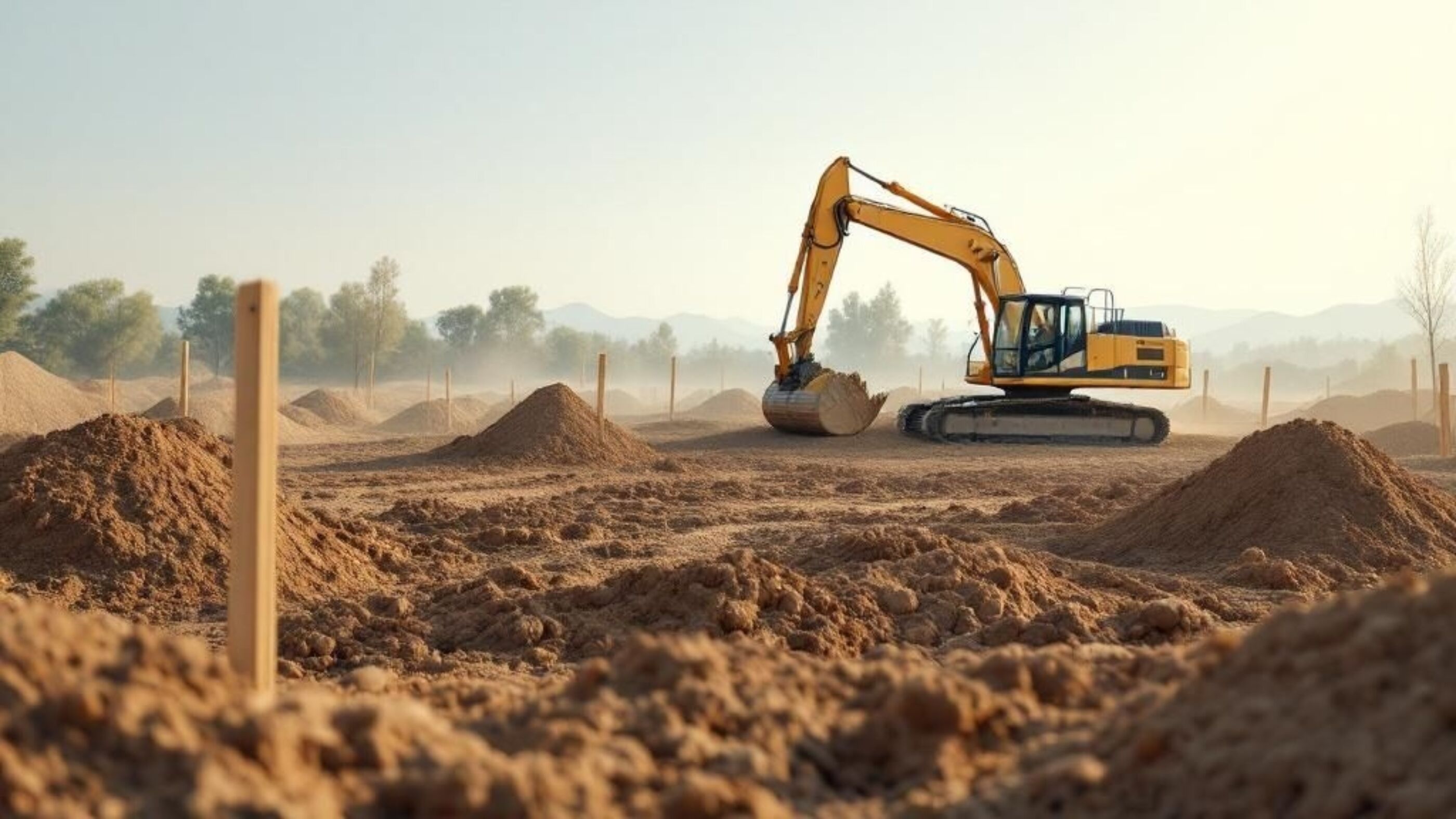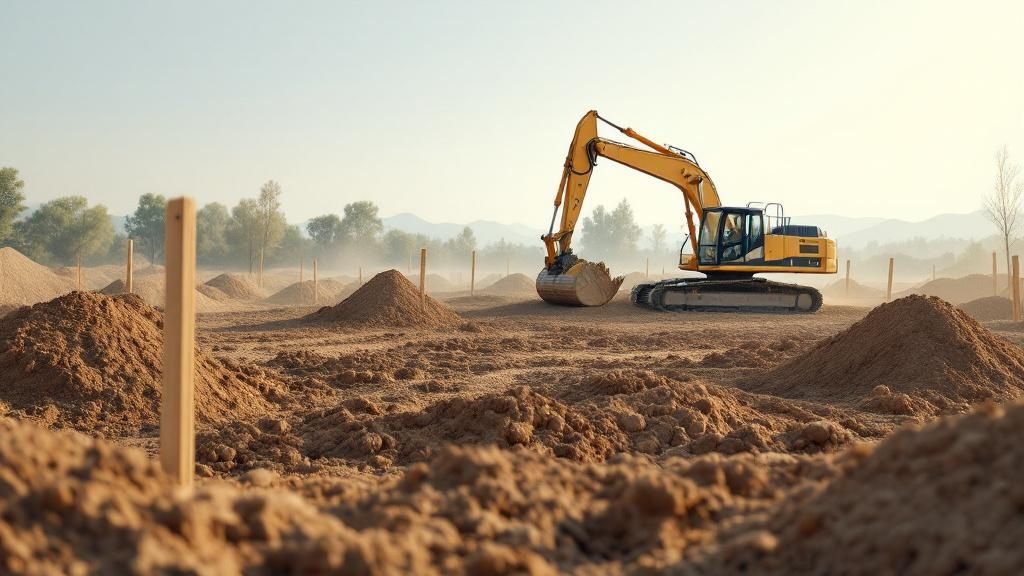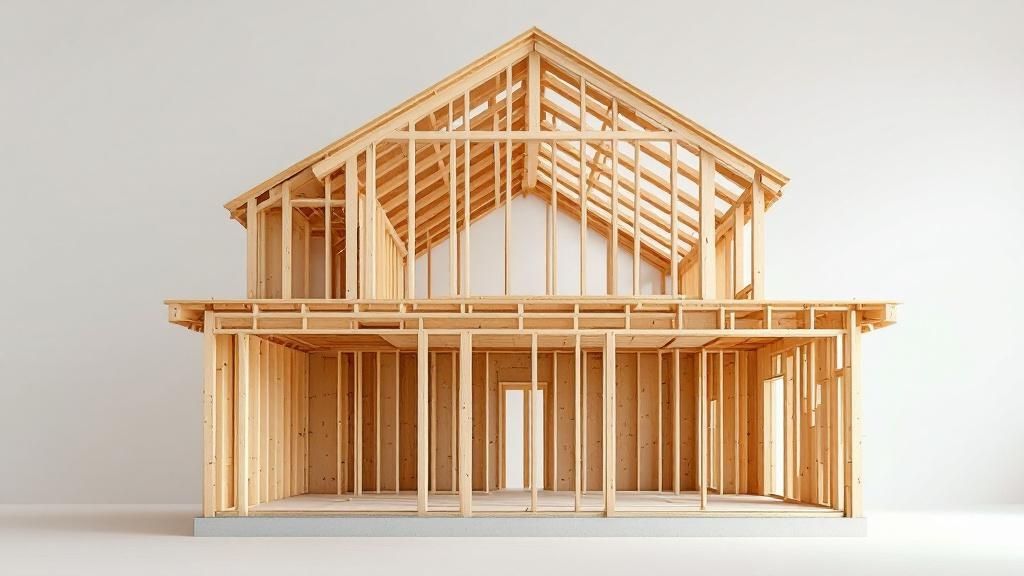Your Complete Guide to the New Home Construction Process

Understanding What Really Happens During Construction
Building a new home can feel like a big step into the unknown. It's perfectly understandable to feel that way! But understanding the process can give you more confidence as you navigate this exciting and complex project. Think of it like planning a long road trip: you’ll want a map, an understanding of the terrain, and the right gear for all kinds of weather.
Key Stages of the Construction Process
Building a new home in Australia, just like anywhere else, typically involves a series of key phases. These stages are all linked, each one building on the one before it. It’s a bit like putting together a complex puzzle, with each piece playing its part in the complete picture.
- Site Preparation: This first stage sets the groundwork – literally. It involves clearing the site, digging the foundations, and making sure there's proper drainage. This creates a solid base for your new home.
- Foundation: This is where your home takes root. The foundation is built according to the structural plans, ensuring stability and durability. It's essential to get this stage right, as any issues here can cause significant problems later on.
- Framing: This stage is like building the skeleton of your house. The framing creates the main structure, including the walls and roof. This is when you’ll really start to see the shape of your home emerge.
- Lock-Up: Once the frame is complete, the house is “locked up.” External walls, windows, and roof coverings are installed to protect the interior from the elements. This is a major milestone in safeguarding your investment.
- Fit-Out: This stage focuses on all the internal work, such as plumbing, electrical wiring, insulation, plastering, and fixture installation. It’s like connecting the nervous system and circulatory system of your house.
- Completion: Time for the final touches! This includes painting, flooring, landscaping, and those all-important final inspections. You're almost ready to move in!
Current Market Conditions and Their Impact
Several factors can influence the home-building process, especially timelines and budgets. A recent report showed Australia's housing supply struggling to keep up with demand, impacting new home construction. In 2024, 111,000 detached houses were completed, similar to pre-pandemic levels. However, only 65,000 higher-density homes were completed, significantly below the 106,000 peak in 2017. Find more detailed statistics here This difference between supply and demand can extend construction times. You might also be interested in: How to master your custom new home design. Changing material costs and the availability of skilled labor can also affect your budget. Careful planning and clear communication with your builder are crucial.
Working with Your Team
Throughout the building process, you'll be working with a variety of professionals – architects, builders, surveyors, and tradespeople. Each one plays a vital role. Building good communication with everyone is key. Regular progress meetings and clear documentation will help keep the project on track and address any problems quickly. Understanding the different phases of construction and working effectively with your team will contribute significantly to a smoother, more successful building experience.
Getting Your Design Right From The Start
Building a new home is an exciting journey, and it all begins with a well-thought-out design. Smart planning during this initial phase can save you significant money and prevent future headaches. Think of it as building a strong foundation—the more solid the groundwork, the smoother the construction process will be.
Choosing the Right Professionals
Selecting the right architect or draftsperson is crucial. These professionals are responsible for translating your vision into concrete plans, ensuring your home is both aesthetically pleasing and functional. Look for professionals with experience in your desired home style and a solid understanding of local building codes. Be wary of poor communication, a lack of fee transparency, and a dismissive attitude towards your ideas. Need help finding the right team? Check out our guide on new home services.
Balancing Wishlist and Budget
Everyone has a dream home in mind, but balancing that dream with your budget requires careful consideration. Prioritize the features that are most important to you and be prepared to compromise on others. For instance, if a gourmet kitchen is a non-negotiable, you might choose a more budget-friendly flooring option in other areas. This strategic approach allows you to create a home you love without breaking the bank.
Creating Detailed Plans
Detailed plans are the roadmap for your new home construction. They should include everything from the layout and room dimensions to the placement of electrical outlets and plumbing fixtures. These details not only guide the builders but also help you visualize the finished product. Remember, changes made during construction are significantly more expensive than those made on paper, so thorough planning is essential.
Essential Considerations: Soil and Energy
Two critical, often overlooked, elements are soil testing and energy efficiency. Soil testing assesses the ground conditions and informs the foundation design, preventing potential structural issues down the line. Investing in energy-efficient features, such as proper insulation and high-performance windows, may have a higher upfront cost, but they significantly reduce long-term energy bills. These are investments that pay dividends over the lifespan of your home.
Making Material Selections
Choosing the right materials for your new home can be overwhelming. From flooring and countertops to roofing and siding, the options seem endless. Thoroughly research different materials, compare prices, and consider their durability and maintenance requirements. This careful selection process ensures you create a home that is both beautiful and built to last.
Navigating The Approval Maze Without Losing Your Mind

Securing building approvals is a critical step in new home construction. It's the gateway to transforming blueprints into bricks and mortar. Understanding the system can make the process manageable, turning a potential headache into a rewarding journey.
Understanding The Approval Process
The approval process is designed to ensure your new home complies with all relevant building codes and regulations. This safeguards your investment and ensures the safety and structural integrity of your build. The process involves submitting detailed plans and specifications to the relevant authorities for review. These plans must adhere to specific guidelines regarding structural integrity, fire safety, accessibility, and environmental considerations.
Permits And Applications: What You Need And When
Knowing which permits you need and when to apply is crucial for a smooth process. This often depends on your project's specifics and location. Common permits include planning permits, building permits, and permits for plumbing and electrical work. Applying early can prevent potential delays.
Private Certifiers Vs. Council Approvals
In Australia, you have a choice between using a private certifier or going through your local council for approvals. A private certifier can often streamline the process, potentially leading to quicker approvals. It’s important to choose a reputable and accredited certifier. Private Certifiers offer a potentially faster route. Council approvals, while sometimes perceived as slower, offer a familiar and established pathway. The best choice depends on your individual project, timeline, and risk tolerance.
Crafting A Bulletproof Application
A well-prepared application is your key to a smooth approval process. This includes providing complete and accurate documentation, clear and detailed plans, and any necessary supporting information. Ensure all measurements are precise and comply with the latest building codes. Clearly documenting your chosen materials can also expedite the process.
Regulatory Changes And Their Impact
Building regulations are subject to change, impacting approval timeframes and requirements. Staying informed about these changes is vital. For example, updates to energy efficiency requirements could necessitate adjustments to your plans. The Australian Bureau of Statistics (ABS) reported 14,633 dwellings approved in April 2025, a 5.7% drop from earlier predictions. House approvals rose 3.1% to 9,349, while other private sector approvals (like apartments) declined 19.0% to 4,999. Explore this data further here. These figures underscore the fluctuating nature of the building industry and the importance of a robust approval strategy. Consulting with your builder or certifier is crucial to understand the latest regulations and their impact on your project.
Tracking Progress From Groundbreaking To Handover
The thrill of seeing your new home come to life is an amazing journey, but it can also be a bit overwhelming. Understanding the construction process, from the very first steps to finally getting the keys, will help keep everything running smoothly and give you peace of mind.
Site Preparation and Foundation
Everything starts with preparing the site. This means clearing the land, marking boundaries, and getting the ground ready for the foundation. This initial groundwork is absolutely vital for your home's stability. The foundation is next, the literal bedrock of your build. This phase includes digging footings, pouring the concrete, and making sure everything perfectly matches the engineering plans. Getting the foundation right is crucial, as problems here can lead to major issues down the line.
Framing and Lock-Up
With the foundation secure, the framing begins. This is where your home truly starts to take shape. Walls, floors, and the roof structure are all built, forming the skeleton of your house. Lock-up follows, where the external walls are clad, windows and doors are fitted, and the roof is finished. This protects the interior from the weather and marks a significant milestone in the building process.
Fit-Out and Completion
The fit-out stage focuses on the inside of your home. This is where plumbing, electrical wiring, insulation, and plasterboard are installed, turning the house into a functional living space. This phase can be quite involved, with various tradespeople working at the same time, so good communication with your builder is essential. The final completion stage includes the finishing touches like painting, flooring, and landscaping. This is where your vision becomes reality, transforming a house into your home.
Managing Delays and Challenges
Unfortunately, delays are a common part of construction. Things like weather, material availability, and unforeseen issues can all affect the timeline. While the Australian residential building sector has shown signs of improvement, with building work completed increasing by 1.6% quarter-over-quarter to $24.27 billion in the first quarter of 2025, a 7% year-over-year rise (Source), delays can still happen. Keeping an open line of communication with your builder is key to proactively addressing any challenges. Resources like this guide on construction quality control can also help you navigate the process effectively and maintain a positive relationship with your builder.
Inspections and Handover
Regular site visits and inspections are crucial for quality control. These checks ensure the work meets building codes and your specifications. The final walkthrough is your last opportunity to spot any defects before you officially take ownership. The handover process involves receiving all the necessary documents, such as warranties and certificates of occupancy. This marks the official completion of the building process and the beginning of your new chapter in your new home.
Keeping Your Budget On Track When Everything Changes

Building a new home is exciting, but managing the budget can be tricky. Unexpected costs can pop up and derail even the most carefully laid plans. Understanding potential problems and taking proactive steps can help you stay in control and avoid financial stress.
Understanding Construction Contracts and Costs
One of the first things you need to do is understand your building contract. There are two main types: fixed-price contracts and cost-plus contracts. A fixed-price contract sets a price upfront for the whole project. This gives you more budget certainty but less flexibility for changes. A cost-plus contract covers the actual construction costs plus a builder's fee. This offers more flexibility but could lead to budget overruns if not managed carefully. Choosing the right contract is crucial for your new home build.
Hidden costs can also catch you off guard. Think about things like site preparation, connecting utilities, and council rates. Include these in your initial budget to avoid surprises down the road.
Identifying and Managing Cost Escalation
Cost escalation is a common issue in new home construction. Material prices can fluctuate, and project scope can change. Recognizing the signs of escalating costs is important. For example, frequent change orders or unexpected delays could signal potential budget problems.
A clear change management process with your builder is key. This process should include a formal way to request changes, get quotes, and approve additional costs. This creates a transparent system for managing modifications.
Mastering the Progress Payment Process
Progress payments are made to the builder at different project milestones. Understanding this process is important for controlling your finances. Make sure the payment schedule matches the actual work completed. Holding back a portion of the payment until each stage is finished to your satisfaction can ensure quality and give you leverage.
Contingency Funds and Scope Creep
A contingency fund is essential for any building budget. This reserve covers unexpected expenses or cost overruns. Setting aside 5-10% of your total budget is usually recommended. This provides a financial safety net.
Scope creep, where the project grows beyond its original plan, often causes budget blowouts. Even small changes can add up quickly. Clearly defining the project scope at the start and sticking to it is vital for budget management.
Negotiating and Accepting Cost Increases
Sometimes, cost increases are unavoidable. If your builder proposes an increase, evaluate it carefully. Is it due to a legitimate rise in material prices or a change in the project scope? Negotiate a fair price if the increase is justified. Sometimes, accepting a cost increase is the best option, especially if it prevents delays or maintains the quality of the build.
Let's look at a typical cost breakdown to give you a clearer picture.
Construction Cost Breakdown for Australian Homes
A detailed breakdown of typical construction costs showing percentages and average amounts for different building phases and components
Construction Phase | Percentage of Total Cost | Typical Cost Range | Key Considerations |
Site Preparation | 10-15% | $30,000 - $40,000 | Soil testing, excavation, permits |
Foundations | 10-15% | $30,000 - $80,000 | Concrete slab, footings, drainage |
Framing | 15-20% | $40,000 - $60,000 | Timber or steel frame, roof trusses |
Lock-up | 15-20% | $50,000 - $80,000 | Walls, roof, windows, doors |
Fixing | 20-25% | $50,000 - $70,000 | Electrical, plumbing, insulation |
Fit-out | 15-20% | $60,000 - $90,000 | Cabinets, flooring, painting |
Finalization | 5-10% | $30,000 - $50,000 | Landscaping, driveway, final inspections |
This table provides a general overview. Actual costs can vary based on location, materials, and design choices. Remember to discuss specific costs with your builder for a more accurate estimate.
Ensuring Quality When It Matters Most

The final stages of building a new home are critical. These steps determine whether you move into the house of your dreams or face potential problems down the line. This phase requires meticulous attention to detail and a proactive approach to ensure everything is perfect. Think of it like the final quality check before receiving a prized possession.
The Critical Inspection Process
Inspections are vital for ensuring a quality build. They are opportunities to identify and address potential issues before they become major headaches. Each inspection, from the initial frame inspection to the final building survey, serves a specific purpose in protecting your investment.
The frame inspection, for example, verifies the home's structural integrity, ensuring it's built to code and can withstand the elements. The final building survey confirms that all aspects of the construction—plumbing, electrical work, and even the finishing touches—meet the required standards. For further information on building and renovations, you might be interested in this article: How to master your home extension or renovation.
Conducting Your Own Quality Assessments
While professional inspections are essential, conducting your own assessments throughout the building process is equally important. This allows you to catch minor issues early and discuss them with your builder promptly.
Create a checklist of items to review during each stage. Pay close attention to details like wall finishes, window and door installations, and the functionality of fixtures. Documenting these observations with photos and written notes can be incredibly helpful when addressing any concerns.
Understanding Your Legal Rights
Understanding your legal rights regarding defects and warranties is crucial. Familiarize yourself with the Home Building Contracts Act 1991 relevant to your state, which outlines the builder’s obligations and your rights as a homeowner.
Also, ensure you receive all applicable warranties for appliances, fixtures, and structural elements. Knowing your rights empowers you to address any defects that may arise during the defects liability period – the timeframe after handover when the builder is responsible for rectifying certain issues.
The Final Walkthrough and Handover
The final walkthrough is your last chance to inspect the completed home before officially taking possession. Use this opportunity to thoroughly examine every aspect of the house, from the functionality of appliances to the quality of the finishes.
Bring your checklist and documentation from previous inspections to confirm that all identified issues have been resolved. During the handover, carefully review the paperwork, including the certificate of occupancy, and ensure you receive all warranties and manuals. This thorough approach ensures you’re fully prepared to move into your new home with confidence, knowing it meets the highest quality standards.
Your Roadmap To Construction Success
The infographic illustrates the final steps in building your new home. It highlights key milestones like the rough inspection (Week 12), the final inspection (Week 14), and receiving the Certificate of Occupancy (Week 15). These milestones, clustered near the project's end, underscore the importance of careful planning in the initial phases. Achieving these milestones marks the successful completion of the project and the beginning of your new home journey.
This final stage represents the culmination of your efforts and planning. Open communication, realistic expectations, and a solid relationship with your building team are crucial for a smooth transition into your new home.
Communication Is Key
Maintaining consistent communication with your builder is essential throughout the entire construction process. Regular meetings and prompt responses to any questions or concerns keep everyone on the same page and prevent misunderstandings. This proactive communication minimizes potential conflicts and allows for efficient resolution of any issues that may arise.
Managing Stress During Construction
Building a new home can be a stressful undertaking. Unexpected delays, budget adjustments, and design decisions can create challenges. Developing coping mechanisms is vital for navigating these hurdles. Staying organized, setting realistic expectations, and acknowledging small victories along the way can significantly reduce stress.
Practical Tips for Staying Organized
A well-organized system for managing documents and monitoring progress helps prevent feeling overwhelmed. Create a dedicated folder for all your building contracts, permits, and invoices. Also, keep a detailed timeline of project milestones and regularly update it with progress notes. This system brings clarity and peace of mind.
Preparing for The Unexpected
Even with meticulous planning, unforeseen issues can occur during construction. Creating a contingency fund for unexpected expenses provides a financial safety net. Setting aside 10-15% of your total budget can cover unforeseen costs, such as material price increases or unexpected site conditions.
Transitioning Smoothly Into Your New Home
Once construction is complete, moving into your new home should be a seamless experience. Before moving in, conduct a thorough final walkthrough with your builder to identify any outstanding items. This proactive step ensures everything is in order before you settle in.
To help you understand the typical timeline and milestones involved in a new home construction project, we've provided a detailed table below:
Construction Phase Timeline and Key Milestones
A comprehensive timeline showing typical durations for each construction phase and critical milestones to track progress.
Construction Phase | Typical Duration | Key Milestones | Inspector Requirements |
Foundation | 3-5 weeks | Excavation, footing, foundation pouring, waterproofing | Footing inspection, foundation inspection, waterproofing inspection |
Framing | 5-7 weeks | Wall framing, roof framing, sheathing, window installation | Framing inspection, roof inspection |
Roofing | 2-3 weeks | Shingle installation, flashing, ventilation | Roofing inspection |
Exterior Finishes | 3-5 weeks | Siding, windows, doors, exterior trim | Siding inspection, window/door inspection |
Interior Finishes | 8-10 weeks | Insulation, drywall, painting, flooring, cabinetry, fixtures | Insulation inspection, drywall inspection, final electrical inspection, final plumbing inspection |
This table provides a general overview of the construction phases, their typical durations, and associated key milestones. Actual timelines can vary depending on project complexity and local regulations. Remember to always consult with your builder for a project-specific schedule.
Building a new home is a significant investment, both financially and emotionally. By following these guidelines, you can navigate the process with confidence and enjoy creating your dream home.
Ready to begin your dream home journey? Contact Envy Abode today to discuss your vision and discover how our expert team can help bring it to life. Learn more about Envy Abode and contact us!